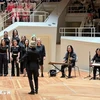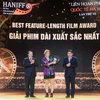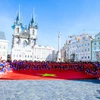 Located in Sa Phin Valley, the 1,200sq.m house was originally the mansion of the most powerful Mong ethnic family in Ha Giang. (Photo: VNA)
Located in Sa Phin Valley, the 1,200sq.m house was originally the mansion of the most powerful Mong ethnic family in Ha Giang. (Photo: VNA)
Hanoi (VNA) – Located in Sa Phin Valley, Dong Van district, the Vuong Mansion is a must-see site for visitors to the northernmost province of Ha Giang, which shares border with China.
The house was originally the mansion of Vuong Chinh Duc, head of the Vuong family – the most powerful Mong ethnic family in the region more than 100 years ago. He proclaimed himself as the King of the region, and adopted the title "Vua Meo", meaning "King of the Meo" (former name of the Mong ethnic group) to dominate the entire northern mountainous region.
During the Nguyen dynasty, King Khai Dinh in 1913 issued a royal proclamation appointing Duc as the sole rule of the frontier region; and today visitors can see the royal proclamation hanging in the main room of the mansion.
Inheriting power from his father, Duc's son, Vuong Chi Sinh, also commanded the region in the early decades of the 20th century before becoming a deputy to the first and second National Assembly of the Democratic Republic of Vietnam (now the Socialist Republic of Vietnam). He was renamed Vuong Chi Thanh by President Ho Chi Minh.
Sinh donated most of his treasure to the Vietnamese resistance government led by President Ho in the war against the French colonialists (1946 – 1954).
To enter the 64-room mansion, visitors have to climb up a series of stone steps sandwiched in between old pine trees leading to the mansion's entrance of a small wooden gate set into a round stone wall.
According to Vuong family history, to build the house, Duc invited a Chinese fengshui master to choose an auspicious location for the building. The tortoise-shaped Sa Phin Valley, was believed to act as symbol of longevity and prosperity, a good omen when combined with the protective belt of eight surrounding mountains.
The mansion's structure is based on the shape of the Chinese character "wang", which also means "wealthy", with four horizontal and six vertical house blocks.
Iron wood, green stone and yin-and-yang double tiles are the main materials used in the construction of the mansion, which combines the typical architectural style of the Chinese Qing dynasty with Mong ethnic features.
Wealth is also represented through the sophisticated dragon, phoenix and bat patterns carved on the mansion's pillars. The Chinese Han character "shou" meaning longevity also can be seen in every roof tile.
It took eight years to complete the two-storey mansion. Covering 1,200sq.m, the complex includes the main area with living room, working room, bedrooms, and additional rooms for servants and guards, food and weapon stores, a kitchen and cattle stable.
Situated in a water-deprived region, the mansion also includes a huge stone tank to retain rain water, which nowadays has become the main water supplier for the valley's residents.
A green area outside the protective wall is the glorious family's graveyard, where visitors can offer incense at the tombs of Sinh and his father. Visitors can see the words "Tan trung bao quoc, bat thu no le" (A life devoted to the nation, never accepting of being a slave) – the epitaph given by President Ho.
Although being recognised as a national architectural and artistic relic site in 1993, the mansion has suffered from a lack of repair and the loss of various valuable household items.
"As an architectural masterpiece of the Mong ethnic people living in the Dong Van karst plateau, the mansion is among one of the must-visit spots whenever tourists come to the region. Local cultural researchers have kept collecting items related to the history of the Vuong family, aiming to turn the mansion into a small museum," said Nguyen Trung Thuong, director of the Ha Giang Culture, Sports and Tourism Department.
Today the mansion not only greets an increasing number of tourists, but also welcomes many professional photographers who are attracted by its unique features and beautiful location./.























